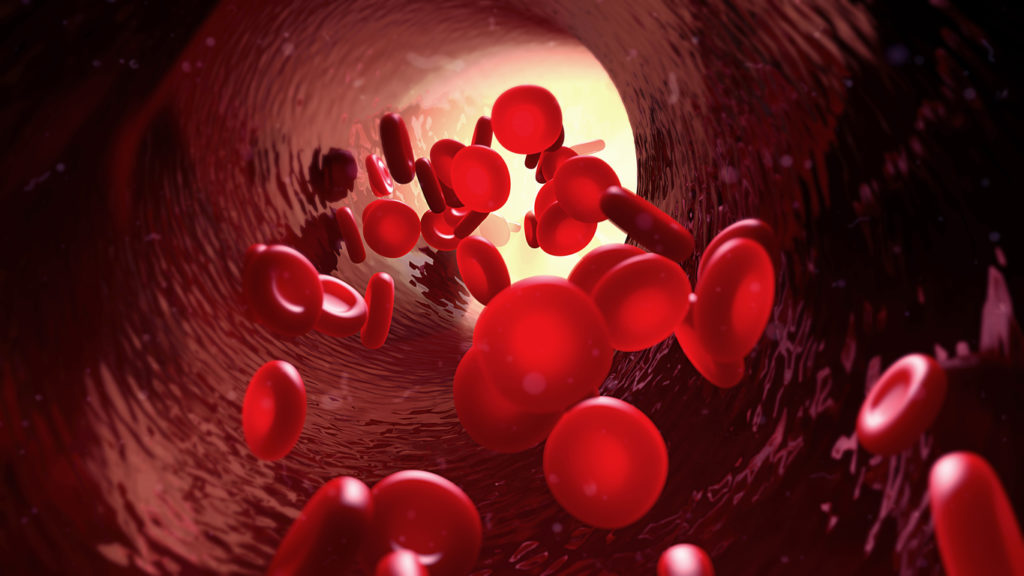Imatinib mesylate may stop the growth of myelofibrosis by blocking certain enzymes necessary for cell growth.
Official Title
Phase II Study of Imatinib Mesylate in Patients With Myelofibrosis
Conditions
– Polycythemia Vera- chronic idiopathic myelofibrosis- Essential Thrombocythemia- Chronic Myelomonocytic Leukemia
Study Type
Interventional
Study Design
Treatment
Further Details
OBJECTIVES:Determine the complete and partial response rate in patients with myelofibrosis treated with imatinib mesylate. Determine the safety of this drug in these patients. Determine the effects of this drug on the bone marrow morphology, including effects on bone marrow fibrosis, osteosclerosis, and cellularity, in these patients. Assess the effects of this drug on surrogate biologic endpoints, including platelet-derived growth factor (PDGFR) expression by immunohistochemistry, PDGFR signaling, and circulating progenitor (CD34 positive) cells, in these patients. Determine the effects of this drug on bone marrow cytogenetics in patients with an abnormal karyotype. OUTLINE: This is a multicenter study. Patients are stratified according to Dupriez risk score (low vs intermediate vs high).Patients receive oral imatinib mesylate once or twice daily on days 1-28. Courses repeat every 28 days for 12 months in the absence of disease progression or unacceptable toxicity. PROJECTED ACCRUAL: A total of 12-35 patients will be accrued for this study within 3-17.5 months.
Study Start
Eligibility & Criteria
Ages Eligible for Study: 18 Years and above, Genders Eligible for Study: Both DISEASE CHARACTERISTICS:One of the following diagnoses: Histologically confirmed myeloid metaplasia with myelofibrosis (MMM) All subtypes eligible Chronic idiopathic myelofibrosis Agnogenic myeloid metaplasia Post-thrombocythemic or post-polycythemic myelofibrosis Must meet the standard Italian Diagnostic Criteria for MMM OR Histologically confirmed chronic myelomonocytic leukemia (CMMOL) with t(5;12)(q31;p12) or TEL-platelet-derived growth factor (PDGFR)-beta rearrangement Patients with CMMOL and the t(5;7)(q33;q11.2) or other chromosomal translocations resulting in activation of PDGFR are also eligible Must meet the standard World Health Organization Diagnostic Criteria for CMMOL Meets criteria for 1 of the following: Anemia (hemoglobin less than 11 g/dL) Splenomegaly by palpation and ultrasound Philadelphia chromosome or bcr-abl rearrangement negative PATIENT CHARACTERISTICS: Age:18 and over Performance status:ECOG 0-2 OR Karnofsky 60-100% Life expectancy:Not specified Hematopoietic:See Disease Characteristics Hepatic:Bilirubin less than 1.5 times upper limit of normal (ULN) AST/ALT less than 2.5 times ULN (unless due to liver involvement with disease) Renal:Creatinine less than 2 times ULN Cardiovascular:No symptomatic congestive heart failure No unstable angina pectoris No cardiac arrhythmia Other:Not pregnant or nursing Negative pregnancy test Fertile patients must use effective barrier contraception during and for up to 3 months after study participation No prior allergic reactions attributed to compounds of similar chemical or biological composition to imatinib mesylate No other uncontrolled concurrent illness No ongoing or active infection No psychiatric illness or social situations that would preclude study compliance PRIOR CONCURRENT THERAPY: Biologic therapy:At least 4 weeks since prior epoetin alfa or filgrastim (G-CSF) No concurrent biologic agents Chemotherapy:At least 4 weeks since prior chemotherapy (6 weeks for nitrosoureas or mitomycin) and recovered No concurrent chemotherapy Endocrine therapy:At least 4 weeks since prior androgenic steroids No concurrent androgenic steroids Radiotherapy:At least 4 weeks since prior radiotherapy, including splenic irradiation No concurrent radiotherapy Surgery:Not specified Other:At least 4 weeks since other prior therapy Any number of prior treatment regimens allowed No other concurrent investigational or commercial anticancer agents or therapies No concurrent combination antiretroviral therapy for HIV-positive patients No concurrent therapeutic anticoagulation with warfarin Concurrent therapeutic anticoagulation with low-molecular weight heparin (e.g., enoxaparin) or unfractionated heparin allowed
Total Enrolment
Contact Details
[1] Olatoyosi M. Odenike, MD, Study Chair, University of Chicago Cancer Research Center [2] National Cancer Institute (NCI) (US)All content and media on the HealthEngine Blog is created and published online for informational purposes only. It is not intended to be a substitute for professional medical advice and should not be relied on as health or personal advice. Always seek the guidance of your doctor or other qualified health professional with any questions you may have regarding your health or a medical condition. Never disregard the advice of a medical professional, or delay in seeking it because of something you have read on this Website. If you think you may have a medical emergency, call your doctor, go to the nearest hospital emergency department, or call the emergency services immediately.







